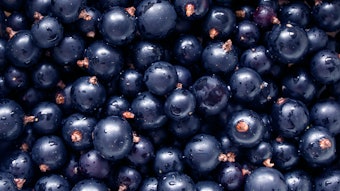The classic use of blackcurrant bud absolute is to reinforce and modify natural or artiflcial blackcurrant flavour; more recently it has found applications in fragrances, especially in the scenting of lipsticks.
Early work on oil composition was carried out by French workers who prepared a nearly colorless oil by benzene extraction followed by steam distillation. Later, a number of major components, mainly monoterpenes, were identified using Kovat’s retention indices.
In an important contribution Williams undertook the first reported organoleptic assessment of blackcurrant bud oil. The majority of odour comments were characteristic of what one would expect from terpenes, being musty, pine-like or reminiscent of turpentine in the lower boiling point region, and spicy aromatic in the higher boiling point region. No particular region could be associated with the ‘catty’ blackcurrant aroma, although some peaks in the terpene hydrocarbon region did have a minty character. Other peaks had green and cucumber aromas, both of which WilIiams considered could contribute to the ‘catty’ note of the buds. One of the high boiling point regions was associated with the heavy, sweet smell of commercial blackcurrant flavours.










